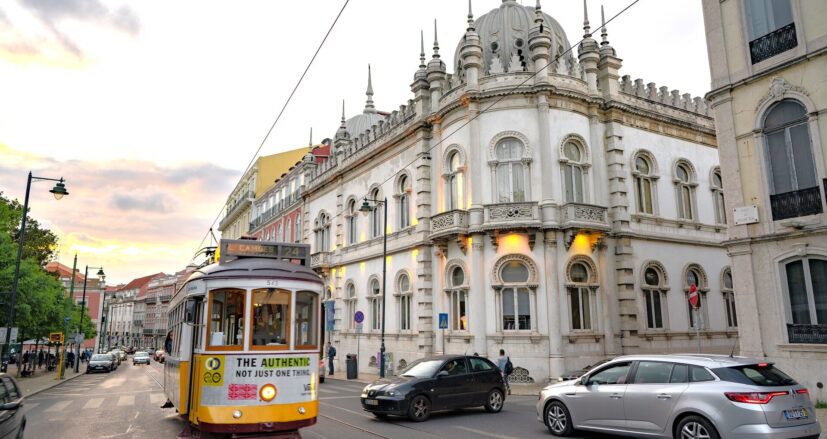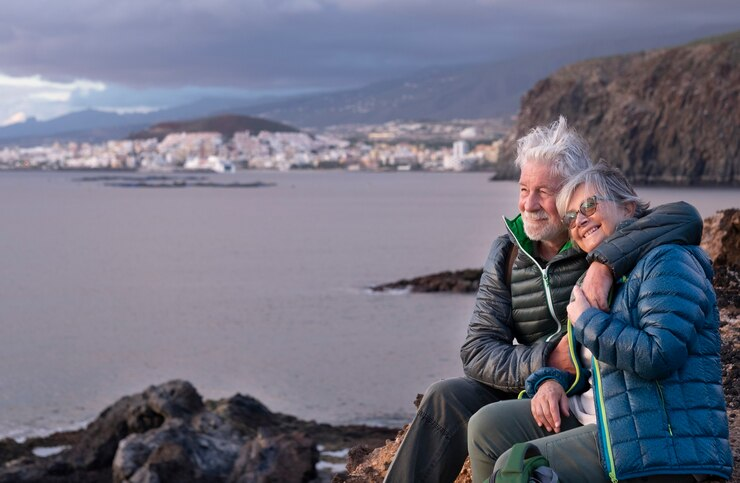A 5 day road trip through the majestic interior of Portugal promises a non-stop slideshow of natural beauty that offers a change from coastal cruising.
Pitched as the ‘Route 66’ of Portugal, the 739km Estrada Nacional No.2 (EN2) is the longest consecutive road in Europe. In one single drive, it offers an unprecedented overview of the myriad wonders that Portugal has to offer. While it’s perfectly alright to embark on this journey in a regular car, campervan hire Portugal from Siesta Campers offers an unmatched level of freedom and flexibility. With bases in Lisbon, Porto & Faro and a popular 1-way hire option, it’s easy to enjoy this journey in either direction.
From North to South, the route encompasses a kaleidoscope of different landscapes, from terraced hills and tree-covered mountains to verdant plains and fertile valleys. A fascinating array of towns, cities, and villages also dot the route, all of them worth a stop (if time allows!).
In fact, one of the biggest challenges with the EN2 is to stay in the campervan and not keep hopping out! With sites of historic, religious, cultural and gastronomic interest around almost every corner, it’s tough to keep on the move.
HIGHLIGHTS:
– Moseying through the majestic Douro Valley
– Visiting the historic towns and villages of Central Portugal
– Cruising through the cork forests and olive groves south of the Tejo River
ROUTE:
Cutting along the ‘spine’ of inland Portugal, the EN2 runs from Chaves on the northern border with Spain to Faro on the Atlantic coast in the far south. Total Driving Time: 5 days (give or take)
DAY 1: INTO THE DOURO VALLEY
HIGHLIGHTS:
– Enjoy a relaxing spa treatment in Chaves
– Take a tour of Mateus Palace and Gardens
– Sample the wines of the Douro
If you choose to begin in the north, campervan hire Porto is a great starting point. There’s a long road ahead, with many twists and turns, so best start in tip-top condition. Famous for its hot springs since Roman times, Chaves boasts a municipal spa like no other. Surrounded by a cluster of hotels (some visitors come for weeks), its expert staff offer a panoply of services based around the city’s silica-rich underground water supply. Visitors can book in for everything from a single hydro massage (highly recommended) through to a full package of different treatments.
Leaving refreshed, start your journey south in earnest. The cathedral in Vila Real is well-worth a visit, although we pressed on to Casa de Mateus. Located slightly off the EN2 (permit yourself a detour or two along the way), this classified national monument used to be the family home of the aristocratic Mateus family – famed for the wines that carry their name. Designed as a “living museum”, the family’s original rooms are now given over to a series of fascinating exhibitions. A walk around the well-kept gardens is also a must.
Soon, you’ll find yourself entering the Douro Valley, one of Portugal’s most distinguished wine regions. Blessed with its own microclimate, the steep-banked hillsides are lined with mile upon mile of terraces, earning the area UNESCO heritage status for its man made landscape. For an unforgettable taste of the Douro’s signature wines, swing a left along the jaw-dropping N222 (voted World Most Beautiful road in 2015) and follow the banks of the Douro upstream. Just before Pinhão, a narrow sideroad takes you up to Quinta do Panascal, the largest and most prestigious vineyard in port house Fonseca’s estate. Park your van and enjoy a guided stroll among the vines, before returning to the visitor centre for a sumptuous port tasting.
Returning to the EN2, you’ll find the small cathedral town of Lamego, which boasts a terrific campsite on top of the hill with fine views down into the urban centre below. Just a five-minute stroll from the campsite is the Sanctuary of our Lady of Remedies, a hilltop church with a vast, ornate staircase that flows down the hillside to the town below.
DAY 2: A DAY AT THE MUSEUMS
HIGHLIGHTS:
– Perk yourself up with a morning infusion
– Take a stroll around historic Viseu
– Visit the potteries of Molelos
It’s never a bad idea to start the day with a cuppa. So, after a quick morning visit to Lamego’s cathedral and city museum, make a pit stop at the organic herbal tea company Ervital (in nearby Mezio). A recent winner of a Great Taste Award in London, this top-notch local tea producer creates incredible infusions from its list of around 100 different herbs.
If you have a weakness for museums, it’s important to toughen up. There are simply too many along the EN2 or near to it to have any hope of visiting them all. One superb local museum that should go on your list, however, is the Linen Museum in the rural settlement of Padrão da Légua. From winnowing to weaving, it lovingly depicts the full process of linen making – once a vital industry from this corner of central Portugal.
Now you’re in the swing, pull up at the ancient Roman city of Viseu (known as the “Garden City” because of its attractive public gardens) and take a stroll around the National Grao Vasco Museum – home to some of the best works of the sixteenth-century Renaissance painter Vasco Fernandes. A stone’s throw away is the city’s remarkable cathedral, which boasts a fine collection of religious art and artefacts as well as the most stunning cloister in all of Portugal. For an expert guide to Viseu’s rich history, drop a line to Neverending Tours – there’s nothing worth knowing that their team of qualified experts cannot tell you.
Another detour for you (again not far!): the Molelos potteries. An example of regional artisanal heritage at its most vibrant, the tiny community of Molelos counts half-a-dozen potteries (including Artantiga, Oleiria Moderna, Oleira Tradicional, Feitiço da Púcara, and Barraca dos Oleiros). The distinctive quality of the pottery is its black hew, the result of the dark smoke produced by the particular species of local pine when fired in the potters’ ovens.
Travel on to Coimbra (okay, okay, it’s not quite on the route), where there are numerous campsite options. One of the best located is Parque Verde do Mondego, perched right on the banks of the Mondego river close to the centre of the city.
DAY 3: THE ANCIENT COIMBRA
HIGHLIGHTS:
– Gaze in wonder at the Johannine Library
– Take to the backroads to see the schist villages
– Dine at the panoramic Ponte Velha restaurant in historic Sertã
The ancient university town of Coimbra has much to commend it, including the superb Botanical Gardens and ornate seminary (Note: for families, there’s great fun to be had at Portugal dos Pequenitos, a depiction of the Portuguese-speaking world in miniature). But the star of the show without doubt is the gold-leafed glory that is the Johannine Library. Built in the grounds of a former palace (now the main university building), the eighteenth-century, book-lined construction feels as much ecclesiastical as it does scholastic: a worthy tribute to the divine nature of books and literature. Tip: contact Madomis Tours for a whistle-stop tour of the city; no-one knows Coimbra better.
The EN2 exists to connect up the interior of Portugal, but there are some tucked-away corners that defy such intent. The schist villages present a case in point. Built from local slate mined from the mountainside, these remote settlements mostly cluster in and around the ‘natural’ park of Serra da Estrela (to the east). Four can be found in the wooded hills near Góis, however, accessible via a looping mountain back road that connects with the EN2. Another superb example, São Simão, is located a little further to the south-west. It sports a delightful river beach in the summer and a terrific restaurant (Varanda do Casal) that operates all year round.
If the road is taking its toil and you feel like stretching your legs, turn off the road at Pedrógão Pequeno towards the Philippine bridge and do the short bridge section of the PR2 trail. Not only is it a beautiful stretch to walk, but the experience will help you build up an appetite for a slap-up meal at the panoramic Ponte Velha restaurant in the castle-capped city of Sertã.
The recently renovated Convento do Serta hotel has space in its carpark for vans. That said, if you’re tempted just once to swap van life for a hotel room, then this would be the optimum time to do so (big plus: it’s within crawling distance of the restaurant!). If you have space, the breakfast is a true treat.
DAY 4: A FEAST FOR THE EYES AND THE STOMACH
HIGHLIGHTS:
– Enjoying oven-fresh bread in Agua Formosa
– Discovering Portuguese pastries of Abrantes
– Listening to the singing waiter in Montemor-O-Novo
In 2017, fires raged uncontrollably across much of Portugal’s central and northern regions, hitting the area around Sertã badly. The government is taking a number of initiatives to help affected communities back on their feet. One of these is a tree-planting project on the edge of Agua Formosa, an isolated mountain village near Vila de Rei. As well as paying to plant your own tree, octogenarian villager Benvinda Santos opens her home for a sumptuous afternoon (or morning) tea of home-made jams and freshly baked bread straight out of her traditional clay oven.
Next stop, the castle-capped city of Abrantes, home to the Knights Templar and the Order of Santiago and later, for many centuries, the preserve of regal proxies, known as “dukes”, who stood in for the Portuguese crown. Today, Abrantes is a delightful town, with two new museums – one dedicated to contemporary art and the other to archaeology – soon in the offing. Many towns along the EN2 have a particular baked good that that are particularly proud of. Carnache do Bonjardim has its almond cartuchos (shells), for example; Castro Daire, its bolo podre (a yummy but unappetising-sounding ‘rotten cake’); Chaves, its meat-filled ‘pastel’. In Abrantes’ case, it’s the sweet, eggy palha (straw) that swells residents’ chests. Tip: try the eponymous Palha de Abrantes bakery on the main square (they also do a mean line in sweet broas).
Crossing the River Tejo at Abrantes, the landscape alters dramatically. Gone are the mountains and hills, replaced by the undulating plains of Alentejo and Algarve. Likewise, hillsides of grapes give way to forests of cork; fields of chestnuts, to rows of citrus fruits. Be sure to stop at the tiny roadside village of Ciborro, bang on the 500km mark, for a photo op. Beside a stone waymark registering the distance is a banner covered with the badges of dozens of bikers’ clubs from across Europe, who organise an annual gathering at the spot.
A little to the south, on the edge of Montemor-O-Novo, is a wayside restaurant called A Ribeira. The food is simple but delicious, yet that’s not the primary reason to go. Carlos Carriço is the real draw. Ask nicely and the restaurant’s super simpatico proprietor-cum-waiter will offer to sing you the entire menu in his own self-composed rap (with backing singing from the kitchen behind). The bill, meanwhile, is fully itemised in a lilting, mournful fado.
If time allows, call in at Chocalhos Pardalinho in Alcáçovas, one of the last (if not the last) of Portugal’s cowbell manufacturers. Once a widespread skill in rural Portugal, the art of bell-making is a dying breed – and, for precisely that reason – it’s now officially recognised as an Intangible Cultural Heritage of Humanity. Not far down the road, on the banks of the Odivelas reservoir, is the picturesque Markadia campsite. Located in an ecological reserve, close to an olive plantation, it’s a favourite among campervan users in the know.
DAY 5: THE COAST BECKONS
HIGHLIGHTS:
– Photographing the mines of Aljustrel
– Checking out the viewpoints
– Kicking back in Faro
Aljustrel (km 618) is home to a very attractive, fourteen-century hermitage, perched in white-washed splendor atop the town’s highest hill. But that’s not really this quiet town’s main selling point: it’s the mines. Citizens of the town have been extractive minerals and metals from beneath the rich, red soil here for centuries. The pits are mostly closed now, but the sight of mineshafts and tailing piles, pylon-like poppet heads and rusting machinery, is hugely evocative of Aljustrel’s former industrial age.
As the coast beckons, the road straightens. This is a landscape of big skies and sweeping vistas. Fortunately, Portugal’s road planners have cottoned on to the fact and built a number of convenient viewpoints along the route.
All that’s left is to roll slowly into Faro, the end of the road. Just how far the EN2 runs is the subject of some dispute, but the general consensus is 739km. That said, don’t waste time searching for a road marker to celebrate the fact: curiously, the last is to be found at 738km. Still, there is far too much to be getting on with in Faro. Park up and head to the old city, where the cathedral and Roman wall provide an eye-opening conclusion to an epic adventure. Time for a celebratory drink? No problem: Faro’s old town has no shortage of cool pavement bars and restaurants to choose from. At this point, it’s time to drop off your campervan. However, campervan hire Faro is a great option if you’d like to do this itinerary in reverse!



